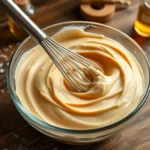We’ve discovered the perfect solution for hectic morning routines – Amish breakfast casserole. This hearty make-ahead dish combines all your breakfast favorites into one satisfying pan that’ll feed the whole family without the fuss.
Rooted in traditional Pennsylvania Dutch cooking, this casserole transforms simple ingredients like eggs, bread, sausage, and cheese into something truly spectacular. The Amish perfected this recipe out of necessity, creating a dish that could easily feed large families while using readily available pantry staples.
What sets this breakfast casserole apart is its incredible versatility and convenience. We can assemble it the night before, pop it in the fridge, and wake up to an almost-ready breakfast that just needs time in the oven. Whether you’re hosting weekend guests, planning a holiday brunch, or simply want to simplify your morning routine, this golden, fluffy casserole delivers restaurant-quality results with minimal effort.
Ingredients
We gather simple pantry staples and fresh ingredients to create this hearty breakfast masterpiece. These components work together to build layers of flavor and texture that make every bite satisfying.
For the Casserole Base
- 8 slices day-old bread, cubed (white or whole wheat)
- 1 pound breakfast sausage, cooked and crumbled
- 2 cups sharp cheddar cheese, shredded
- 1 cup frozen hash browns, thawed
- 1/2 cup green bell pepper, diced
- 1/4 cup yellow onion, finely chopped
- 2 tablespoons butter, melted
For the Egg Mixture
- 8 large eggs
- 2 cups whole milk
- 1 teaspoon salt
- 1/2 teaspoon black pepper
- 1/2 teaspoon garlic powder
- 1/4 teaspoon paprika
- 1 tablespoon fresh chives, chopped
For the Topping
- 1/2 cup sharp cheddar cheese, shredded
- 1/4 cup panko breadcrumbs
- 2 tablespoons butter, melted
- 1 tablespoon fresh parsley, chopped
- 1/4 teaspoon garlic powder
Equipment Needed
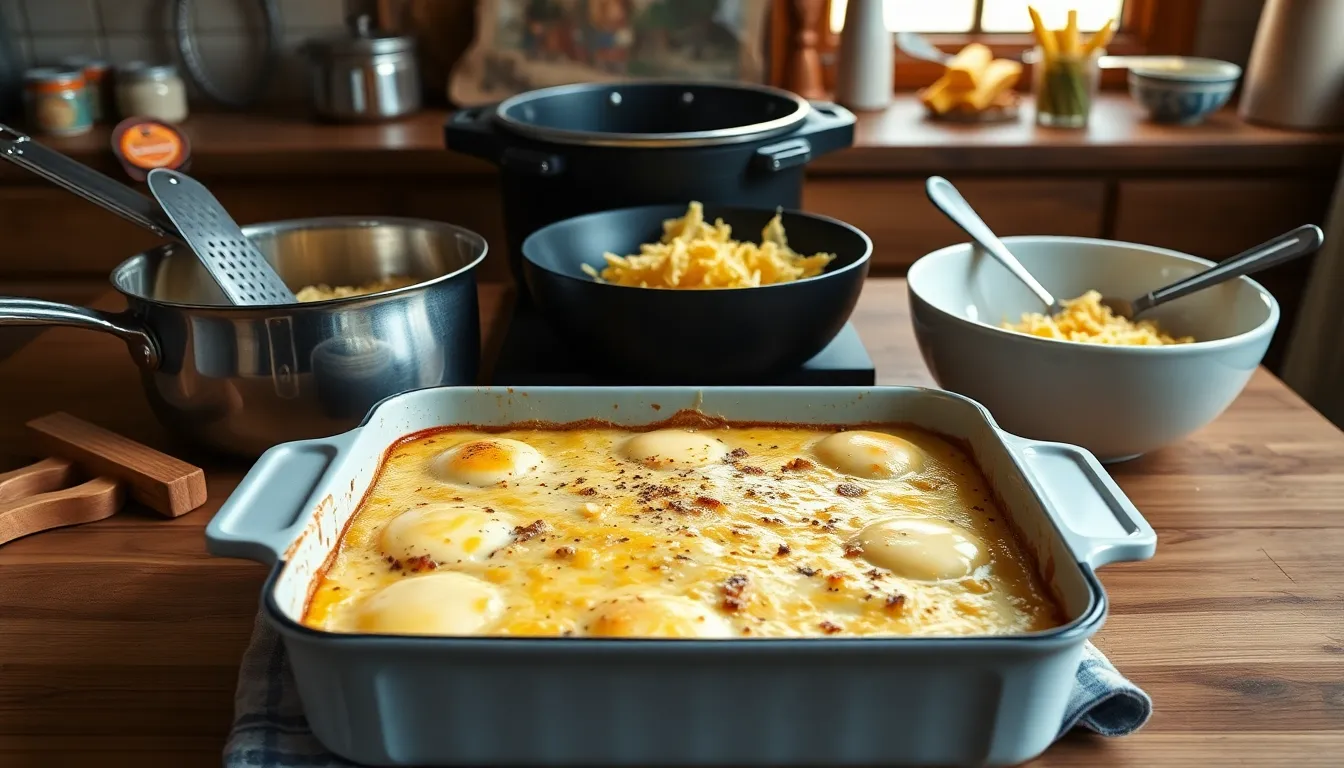
Creating this comforting Amish breakfast casserole requires basic kitchen equipment that most home cooks already have. We recommend gathering these essential tools before starting to ensure smooth preparation and optimal results.
Essential Baking Equipment
A 13×9-inch baking dish serves as the foundation for our casserole, providing the perfect size to feed a crowd while ensuring even cooking throughout. This standard rectangular dish allows the ingredients to spread evenly and creates ideal portion sizes for serving.
Stovetop Preparation Tools
We need a large skillet for browning the sausage and sautéing vegetables to develop rich flavors before adding them to our casserole. A meat chopper or sharp knife helps break up the sausage into uniform pieces, ensuring consistent distribution throughout the dish.
Mixing and Measuring Essentials
Large mixing bowls are crucial for combining our egg mixture and assembling all ingredients without spilling. We recommend using liquid and dry measuring cups along with measuring spoons to ensure accurate proportions that deliver consistent results every time.
Additional Helpful Tools
A cheese grater becomes necessary if using block cheeses rather than pre-shredded varieties, giving us better melting quality and fresher flavor. Having these tools ready transforms our cooking process from chaotic to organized, allowing us to focus on creating layers of delicious flavors rather than searching for equipment mid-recipe.
Each piece of equipment plays a exact role in building our breakfast masterpiece, from the initial preparation through the final golden-brown presentation.
Instructions
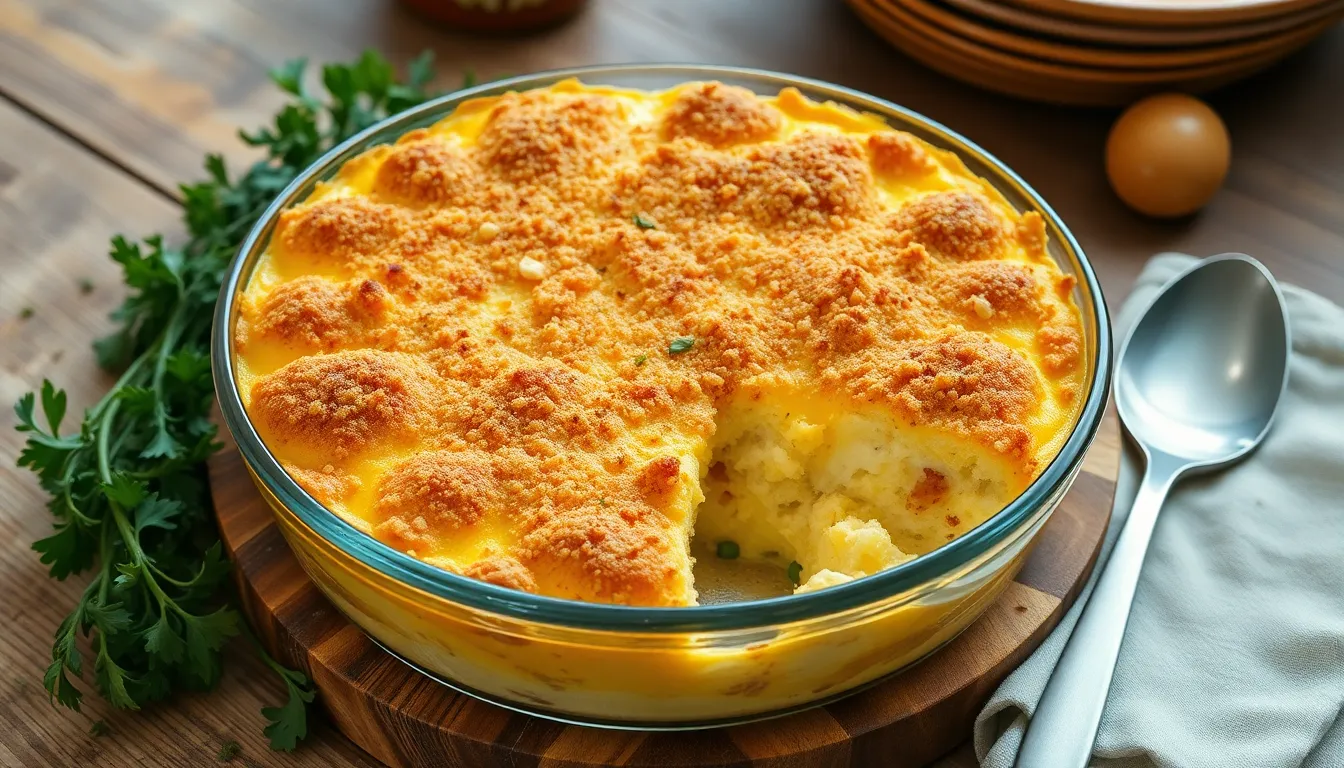
We’ll walk you through each step to create this hearty breakfast masterpiece that serves your family perfectly. The process involves layering ingredients strategically to achieve that signature golden top and fluffy interior.
Prep the Casserole Base
We start by cooking 1 pound of bacon or ground pork sausage in a large skillet over medium heat until browned and fully cooked. Drain the excess grease and set the meat aside on paper towels. Next we chop 1 medium onion and 1 small green pepper into small pieces. Cook these vegetables in the same skillet with any remaining bacon fat until the onion becomes translucent and the pepper softens. This takes about 5 minutes. Remove from heat and let the mixture cool slightly.
Meanwhile we arrange our day-old bread cubes in the greased 13×9-inch baking dish to create an even base layer. Sprinkle the cooked meat and vegetable mixture over the bread. Add the thawed hash brown potatoes in an even layer followed by the sharp cheddar cheese.
Prepare the Egg Mixture
We whisk 6 to 7 large eggs in a large mixing bowl until well blended and smooth. Pour in the whole milk and continue whisking until completely combined. Season the mixture with salt black pepper garlic powder and paprika. Beat everything together until the spices are evenly distributed throughout the egg mixture. The consistency should be smooth without any lumps.
Add 1 to 2 cups of cottage cheese and 1 to 2 cups of Swiss cheese to the egg mixture. Stir gently until all cheese varieties are incorporated. Fresh chives get folded in last to maintain their bright color and fresh flavor.
Assemble the Casserole
We pour the prepared egg mixture slowly over the layered ingredients in the baking dish. Use a fork to gently press down any bread pieces that float to ensure even saturation. The liquid should reach most corners of the dish and cover the majority of the solid ingredients. Let the casserole sit for 10 minutes to allow the bread to absorb some of the egg mixture.
Rock the dish gently from side to side to help distribute the liquid evenly. This step ensures every bite contains the perfect balance of ingredients when baked.
Add the Topping
We combine panko breadcrumbs with melted butter in a small bowl until the crumbs are evenly coated. Mix in garlic powder and fresh parsley for extra flavor and color. Sprinkle the remaining sharp cheddar cheese evenly across the top of the casserole. Follow with the seasoned breadcrumb mixture to create that signature golden crust.
Preheat the oven to 350°F and bake for 35 to 40 minutes until a knife inserted near the center comes out clean. The top should be golden brown and the center should feel set when gently shaken. Let the casserole rest for 10 minutes before serving to allow the layers to settle properly.
Baking Directions

The oven temperature plays a crucial role in achieving the perfect Amish breakfast casserole texture. We preheat our oven to 350°F to ensure even cooking throughout the dish. This moderate temperature allows the eggs to set properly without overcooking the top layer.
Position the oven rack in the center before baking begins. We place our prepared 13×9-inch baking dish on the middle rack for optimal heat circulation. The casserole requires 35 to 40 minutes of baking time to reach the ideal doneness.
| Baking Stage | Time | Temperature | Visual Cues |
|---|---|---|---|
| Initial Baking | 25 minutes | 350°F | Edges begin to set |
| Final Stage | 10-15 minutes | 350°F | Golden brown top |
| Rest Period | 10 minutes | Room temp | Firm center |
Testing for doneness requires inserting a clean knife near the center of the casserole. We know the dish is ready when the knife comes out clean without any wet egg mixture clinging to it. The top should display a beautiful golden brown color with slightly crispy edges.
Steam will rise from the surface when the casserole reaches proper internal temperature. We check that the center feels firm to the touch rather than jiggly. The cheese should be completely melted and bubbling around the edges of the baking dish.
Resting time is essential after removing the casserole from the oven. We allow the dish to sit undisturbed for 10 minutes before serving. This cooling period helps the layers set properly and makes slicing much easier.
The finished casserole should maintain its shape when cut into squares. We use a sharp knife to create clean portions that showcase all the delicious layers. Each serving reveals the beautiful combination of eggs, cheese, meat, and hash browns baked to perfection.
Make-Ahead Instructions
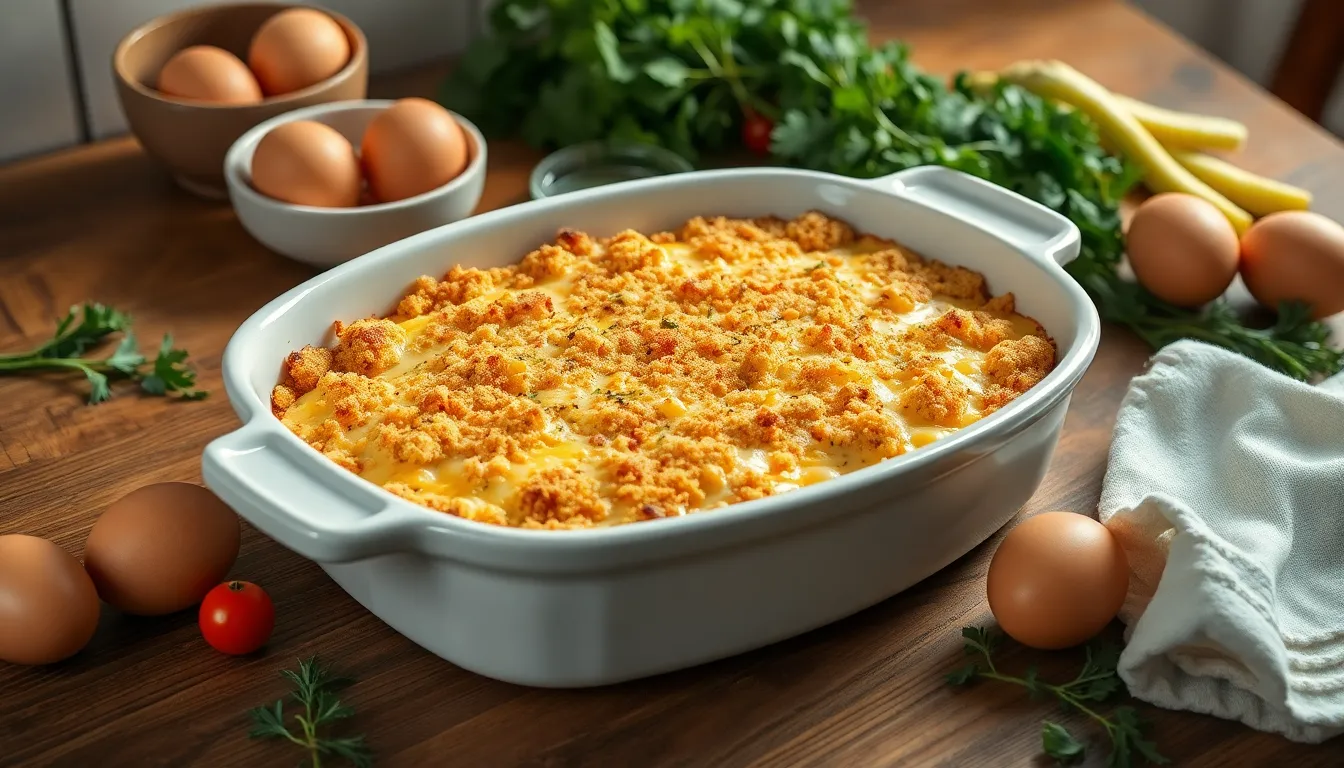
One of the greatest advantages of our Amish breakfast casserole is its ability to be prepared entirely in advance. This flexibility transforms busy mornings into stress-free experiences.
Overnight Preparation
We recommend assembling the entire casserole the evening before you plan to serve it. Follow all the preparation steps through adding the breadcrumb topping, then cover the baking dish tightly with plastic wrap or aluminum foil. Store the covered casserole in the refrigerator overnight, allowing the bread to fully absorb the egg mixture and the flavors to meld together.
Remove the casserole from the refrigerator 30 minutes before baking to bring it closer to room temperature. This step ensures even cooking throughout the dish. Bake according to the original instructions, adding an extra 5 to 10 minutes to the cooking time since the casserole will be starting from a cold temperature.
The overnight method actually improves the texture and flavor of our casserole. The bread becomes more custard-like as it absorbs the seasoned egg mixture, while the cheese and seasonings distribute more evenly throughout the dish.
Freezing Instructions
Our Amish breakfast casserole freezes beautifully for up to three months when properly prepared. Assemble the casserole completely but do not bake it. Wrap the unbaked casserole tightly with plastic wrap, then cover with a layer of aluminum foil to prevent freezer burn.
Label the wrapped casserole with the date and baking instructions before placing it in the freezer. We suggest using a permanent marker to write the baking temperature and time directly on the foil for easy reference.
When ready to serve, thaw the frozen casserole in the refrigerator for 24 hours. Remove the wrapping and allow the casserole to sit at room temperature for 30 minutes before baking. Follow the original baking instructions, adding 10 to 15 minutes to ensure the center is completely heated through and the top achieves that perfect golden brown color.
Serving Suggestions

We find that the beauty of this Amish breakfast casserole lies in its versatility when it comes to serving options. A dollop of sour cream on each portion adds a cool, creamy contrast to the warm, cheesy layers. Salsa brings a bright, zesty element that cuts through the richness beautifully.
Fresh herbs elevate the presentation and flavor profile significantly. We love sprinkling chopped parsley or fresh chives over individual servings just before they reach the table. Diced tomatoes provide a fresh, colorful garnish that adds both visual appeal and a burst of acidity to balance the hearty ingredients.
For those seeking additional protein, we recommend serving crispy bacon strips or a small portion of scrambled eggs alongside each square. These complementary proteins create a more substantial meal without overwhelming the casserole’s flavors.
Lighter accompaniments work wonderfully to round out the meal. Fresh fruit such as sliced strawberries, mixed berries, or melon chunks provide natural sweetness and help cleanse the palate. Greek yogurt offers another cooling element while adding beneficial probiotics to the breakfast spread.
We’ve discovered that no special serving equipment is necessary for this dish. A standard spatula or large serving spoon handles portioning with ease. The casserole maintains its structure well when cut into neat squares, making individual servings simple to plate.
This versatile dish shines at various occasions throughout the day. We serve it confidently at breakfast gatherings, weekend brunches, and holiday morning celebrations. The leftovers reheat exceptionally well in the microwave or oven, making them perfect for quick weekday breakfasts or late morning snacks.
Storage and Reheating Tips
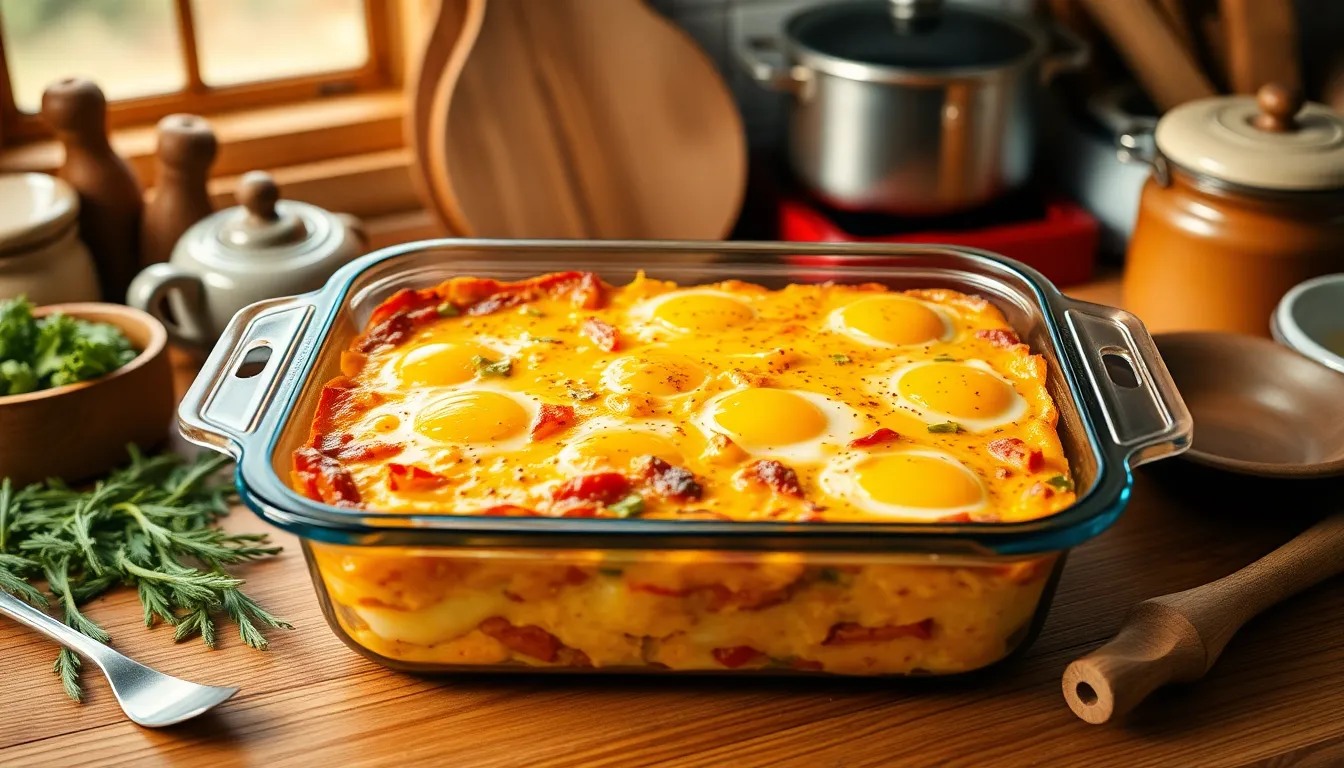
Proper Storage Methods
Our Amish breakfast casserole stores beautifully for future meals when handled correctly. We recommend transferring leftover portions to an airtight container and refrigerating them for optimal freshness. The casserole maintains its quality in the refrigerator for up to 4 days when stored properly.
Freezing offers an excellent long-term storage solution for larger portions. We wrap individual servings or the entire casserole tightly with plastic wrap and aluminum foil to prevent freezer burn. Using freezer-safe containers provides additional protection against moisture and odors. Properly frozen casserole remains delicious for up to 3 months.
Reheating Techniques
| Reheating Method | Temperature | Time | Best For |
|---|---|---|---|
| Microwave | High power | 1-2 minutes | Individual servings |
| Oven | 350°F (175°C) | 15-25 minutes | Larger portions |
Microwave Method: We place individual servings on microwave-safe dishes and heat for 1 to 2 minutes until warmed through. This method works perfectly for quick breakfast answers on busy mornings.
Oven Method: Larger servings or whole casserole portions reheat best in the oven at 350°F for 15 to 25 minutes. We cover the dish with foil to prevent the top from browning too quickly while ensuring the center heats completely.
Thawing Guidelines
Frozen casserole requires proper thawing before reheating for best results. We transfer the frozen portion to the refrigerator and allow it to thaw overnight. This gradual thawing process maintains the casserole’s texture and prevents uneven heating during the reheating process.
Customization Options
Storage time provides an excellent opportunity to plan variations for future servings. We can customize leftover portions by adding fresh vegetables or experimenting with different cheese varieties when reheating. These modifications create new flavor profiles while utilizing stored casserole effectively.
Recipe Variations
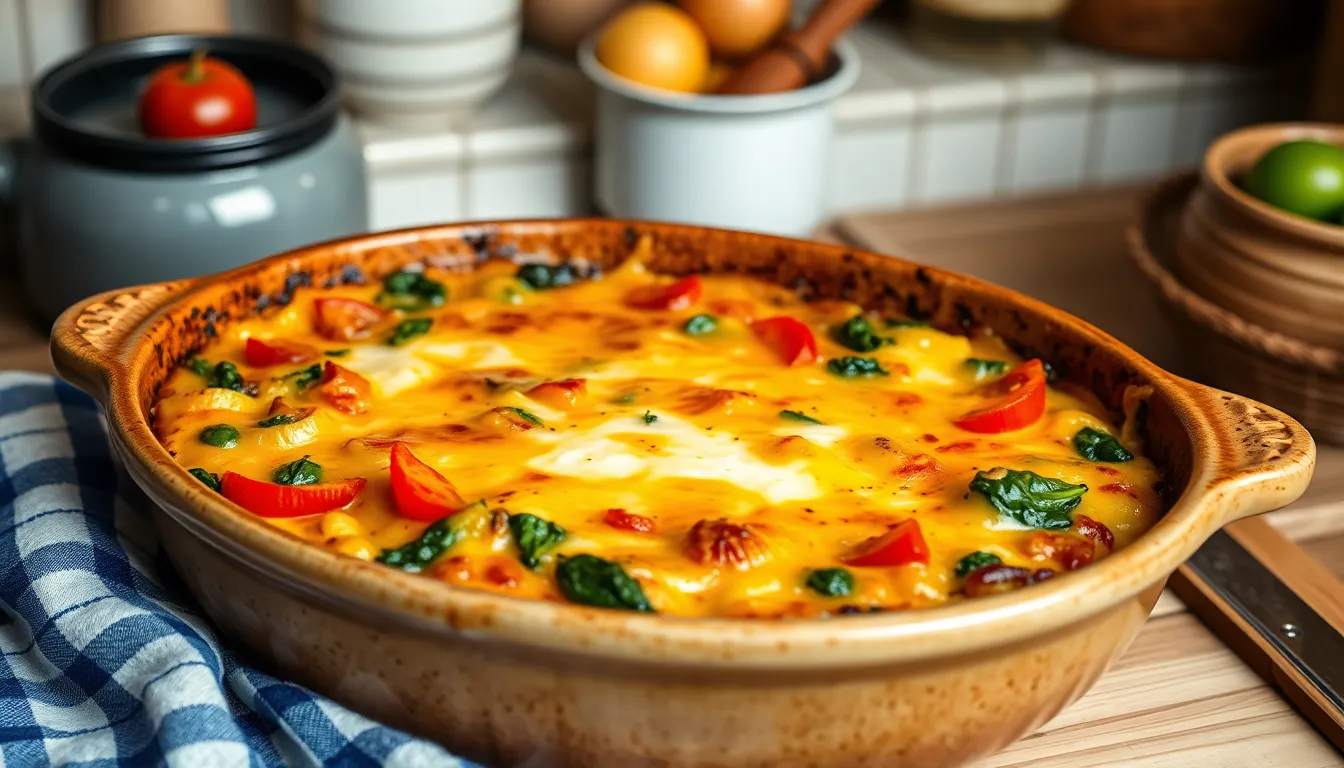
We love how adaptable this Amish breakfast casserole recipe can be to suit different dietary preferences and flavor profiles. Our variations maintain the comforting essence while offering exciting new twists on the classic dish.
Vegetarian Option
We can easily transform this hearty casserole into a satisfying vegetarian meal by eliminating the meat and improving the vegetable content. Our vegetarian version incorporates fresh spinach, bell peppers, tomatoes, and mushrooms to create layers of flavor and nutrition. We recommend adding vegetarian sausage crumbles or cubed tofu for protein while maintaining the dish’s substantial texture.
Cottage cheese works wonderfully in our meatless version, providing richness and creaminess that complements the egg mixture. We suggest using extra shredded cheese varieties like cheddar, Monterey Jack, or Colby to ensure each bite remains indulgent. Our vegetarian adaptation delivers the same make-ahead convenience while offering a lighter yet satisfying breakfast experience.
Spicy Version
We elevate the heat level by incorporating chopped jalapeños or serrano peppers directly into the egg mixture for consistent spice distribution. Our spicy variation includes a dash of hot sauce blended with the eggs and milk, creating a subtle warmth throughout the casserole. We recommend substituting chorizo for traditional bacon or sausage to introduce bold, smoky flavors that complement the heat.
Our Southwestern-inspired version features cumin and chili powder mixed into the egg base, while extra bell peppers add both heat and vibrant color. We find that red bell peppers work particularly well in spicy versions, providing sweetness that balances the heat. These modifications create a breakfast casserole with personality that wakes up the taste buds.
Healthier Alternatives
We create lighter versions by substituting lean turkey sausage or lean ham for traditional high-fat meats while reducing overall salt content. Our healthier approach includes increasing the vegetable ratio, incorporating nutrient-dense options like spinach, zucchini, or broccoli for added fiber and vitamins. We suggest using reduced-fat cheese varieties or simply reducing the total cheese quantity while maintaining flavor.
For our low-carb adaptation, we replace or reduce the potato content with cauliflower florets or other low-carb vegetables that provide similar texture. We recommend using egg whites or a combination of whole eggs and egg whites to reduce cholesterol while maintaining protein content. These modifications allow us to enjoy this comfort food classic while supporting various nutritional goals.
Conclusion
We’ve shown you how this versatile Amish breakfast casserole can transform your morning routine into something truly special. Whether you’re feeding weekend guests or planning ahead for busy weekdays this recipe delivers consistent results with minimal fuss.
The beauty of this dish lies in its adaptability and convenience. You can customize it to match your family’s preferences add your favorite vegetables or adjust the spice level to create your perfect breakfast masterpiece.
With proper storage techniques and make-ahead options you’ll always have a satisfying meal ready when you need it most. This casserole proves that hearty homestyle cooking doesn’t have to be complicated to be absolutely delicious.
Frequently Asked Questions
What is an Amish breakfast casserole?
An Amish breakfast casserole is a hearty, one-dish meal rooted in Pennsylvania Dutch cooking traditions. It combines breakfast favorites like eggs, bread, sausage, cheese, and hash browns into a single baked dish. This versatile casserole can feed large families and is perfect for busy mornings or hosting guests.
Can I prepare Amish breakfast casserole the night before?
Yes, this casserole is perfect for make-ahead preparation. You can assemble it completely the evening before, cover tightly, and refrigerate overnight. This actually enhances the flavors and texture as the bread absorbs the egg mixture. Simply bake it in the morning according to the recipe directions.
What equipment do I need to make this casserole?
You’ll need basic kitchen equipment that most home cooks already have: a 13×9-inch baking dish, large skillet for browning sausage, mixing bowls, measuring cups and spoons, and a cheese grater if using block cheese. These simple tools ensure smooth preparation and even cooking results.
How long does it take to bake the casserole?
Bake the casserole at 350°F for 35-40 minutes total. Start with 25 minutes until edges begin to set, then continue for 10-15 minutes until the top is golden brown. Test doneness by inserting a knife near the center – it should come out clean when fully cooked.
How long can I store leftover casserole?
Leftover casserole can be refrigerated in an airtight container for up to 4 days. For longer storage, wrap tightly and freeze for up to 3 months. Individual servings reheat well in the microwave for 1-2 minutes, while larger portions should be reheated in the oven at 350°F.
What variations can I make to this recipe?
You can customize this casserole in many ways: create a vegetarian version with spinach and mushrooms, add jalapeños for spice, or make a Southwestern version with cumin and chili powder. For healthier options, use lean turkey sausage, add more vegetables, or substitute cauliflower for hash browns.
What should I serve with Amish breakfast casserole?
This versatile dish pairs well with various toppings and sides. Try sour cream, salsa, fresh herbs like parsley or chives, or diced tomatoes. For a balanced meal, serve with fresh fruit, Greek yogurt, or crispy bacon. It’s perfect for breakfast gatherings and holiday celebrations.


